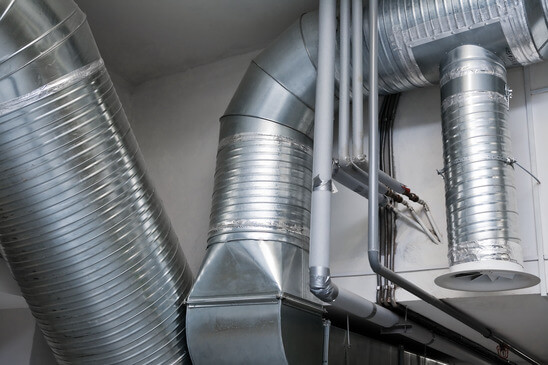
Ducts are conduits or passages used in heating, ventilation, and air conditioning (HVAC) to deliver and remove air. The needed airflows include supply air, return air, and exhaust air. Ducts commonly also deliver ventilation air as part of the supply air. As such, air ducts are one method of ensuring acceptable indoor air quality as well as thermal comfort.
Ducts can be made out of the following materials:
Galvanized mild steel is the standard and most common material used in fabricating ductwork because the zinc coating of this metal prevents rusting and avoids cost of painting. For insulation purposes, metal ducts are typically lined with faced fiberglass blankets (duct liner) or wrapped externally with fiberglass blankets (duct wrap). When necessary, a double walled duct is used. This will usually have an inner perforated liner, then a 1–2" layer of fiberglass insulation contained inside an outer solid pipe. Rectangular ductwork is commonly fabricated to suit to suit your needs by specialized metal shops. For ease of handling, it most often comes in 4' sections (or joints). Round duct is made using a continuous spiral forming machine which can make round duct in nearly any diameter when using the right forming die and to any length to suit, but the most common stock sizes range evenly from 4" to 24" with 6"-12" being most commonly used. Stock pipe is usually sold in 10' joints. There are also 5' joints of the non-spiral type pipe available, which is commonly used in residential applications.
Aluminium ductwork is lightweight and quick to install. Also, custom or special shapes of ducts can be easily fabricated in the shop or on site. The ductwork construction starts with the tracing of the duct outline onto the aluminium preinsulated panel. The parts are then typically cut at 45°, bent if required to obtain the different fittings (i.e. elbows, tapers) and finally assembled with glue. Aluminium tape is applied to all seams where the external surface of the aluminium foil has been cut. A variety of flanges are available to suit various installation requirements. All internal joints are sealed with sealant. Aluminum is also used to make round spiral duct, but it is much less common than galvanized steel.
Traditionally, air ductwork is made of sheet metal which was installed first and then lagged with insulation. Today, a sheet metal fabrication shop would commonly fabricate the galvanized steel duct and insulate with duct wrap prior to installation. However, ductwork manufactured from rigid insulation panels does not need any further insulation and can be installed in a single step. Both polyurethane and phenolic foam panels are manufactured with factory applied aluminium facings on both sides. The thickness of the aluminium foil can vary from 25 micrometres for indoor use to 200 micrometres for external use or for higher mechanical characteristics. There are various types of rigid polyurethane foam panels available, including a water formulated panel for which the foaming process is obtained through the use of water and CO 2 instead of CFC, HCFC, HFC and HC gasses. Most manufacturers of rigid polyurethane or phenolic foam panels use pentane as foaming agent instead of the aforementioned gasses.
Fiberglass duct board panels provide built-in thermal insulation and the interior surface absorbs [sound], helping to provide quiet operation of the HVAC system. The duct board is formed by sliding a specially-designed knife along the board using a straightedge as a guide. The knife automatically trims out a groove with 45° sides which does not quite penetrate the entire depth of the duct board, thus providing a thin section acting as a hinge. The duct board can then be folded along the groove to produce 90° folds, making the rectangular duct shape in the fabricator's desired size. The duct is then closed with outward-clinching staples and special aluminum or similar metal-backed tape.
Flexible ducts (also known as flex) are typically made of flexible plastic over a metal wire coil to shape a tube. They have a variety of configurations. In the United States, the insulation is usually glass wool, but other markets such as Australia, use both polyester fibre and glass wool for thermal insulation. A protective layer surrounds the insulation, and is usually composed of polyethylene or metalised PET. It is commonly sold as boxes containing 25' of duct compressed into a 5' length. It is available in diameters ranging from as small as 4" to as big as 18", but the most commonly used are even sizes ranging from 6" to 12". Flexible duct is very convenient for attaching supply air outlets to the rigid ductwork. It is commonly attached with long zip ties or metal band claps. However, the pressure loss is higher than for most other types of ducts. As such, designers and installers attempt to keep their installed lengths (runs) short, e.g. less than 15 feet or so, and try to minimize turns. Kinks in flexible ducting must be avoided. Some flexible duct markets prefer to avoid using flexible duct on the return air portions of HVAC systems, however flexible duct can tolerate moderate negative pressures. The UL181 test requires a negative pressure of 200 Pa.
Talk to us today for more information on the viability of mechanical ducts in your building.